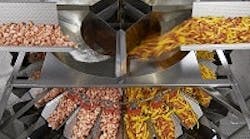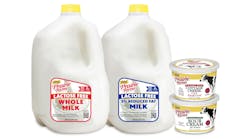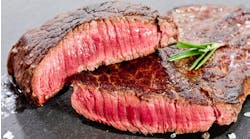From the moment raw materials enter a food plant until finished goods exit, their physical weight is monitored, preferably with the greatest possible precision.
From load cells under storage bins to checkweighers in front of casepackers and beyond, weighing systems provide immediate feedback on whether or not a process is under control. Sounds simple, but the abusive nature of the industrial environment, along with faster line speeds and the variability of throughput rates, can defeat the most sophisticated weighing technologies.
"Food plants used to rely on hand scoops and static scales," muses Brian Barr, sales manager of packaging systems at Hayward, Calif.-based Heat and Control Inc., with offices in Lititz, Pa. "Now, based on throughput requirements and the need for reliability, you need 'intelligent' equipment that is also simple to operate." Add to that the peculiarities of a given manufacturer's production process, and even the most advanced technology may be found wanting.
Dry pet food is an example. Before they can extrude the material Fido recognizes as kibble, manufacturers like Chenango Valley Pet Foods in upstate New York creates viscous slurry of meat, vegetables and water. The slurry used to be pumped through a Coriolis flow meter en route to the mill/extruder. Unfortunately, entrained air and a noisy flow-rate signal back to the pump resulted in periodic upsets. After investigating flow-meter options and not finding one that measured up to the accuracy and reliability Chenango desired, the firm took a different tack: a loss-in-weight system for the slurry. Three years ago, a progressive cavity pump combined with cable scales and controls from Hyer Industries Inc.'s Thayer Scale division in Pembroke, Mass., was commissioned. Within 60 seconds of start-up or a set-point change, the system is within 1 percent accuracy and is immune to changes in makeup or flowability of a slurry that is pumped at anywhere from 5-65 lbs. a minute. According to Tom Picone, Thayer's vice president-sales and marketing, the system is a virtual standard for today's pet-food production.
Loss-in-weight systems are more commonly associated with dry materials, including cereal and snack foods, but the pet food example illustrates the difficulties of controlling complex food materials in a high-throughput industrial environment. "Precision is very important today," Picone points out, and an integrated solution is no better than its weakest component. "We're limited by the accuracy of the pump," he says, and unless the feed to the scale is reasonably precise, the best load cell won't achieve its potential accuracy. The good news is that OEMs are scaling up to deliver larger components that meet food manufacturers' goal of higher throughput without loss of precision.
Combination weighers have served food manufacturers for 30 years, though more stringent requirements drove numerous advancements in the RV series from Ishida. Photo: Heat and Control Inc.
Thayer has built loss-in-weight feeders for 50 years, first to control resin flow in fabricating oriented strand board in the wood industry before shifting to food production. Today, all of the firm's load cells are stainless steel. Its cable scales boast Thayer's force measurement suspension system, which cancels out the effects of vibration and the inevitable bumps and knocks of the production environment. Its load cells often are used with screw and rotary valve feeders, but for optimum performance, vibratory conveyors are used.
When a hopper and feeder are mounted on four load cells, off-center loading can overload and destroy a cell. Thayer overcame that problem in recent years with its cable flexure suspension scale, says Picone. "If you're down because you broke a load cell or you're not feeding materials right, there's a big cost," he says.
Like loss-in-weight scales, combination weighers are transitioning from dry goods to wet products, such as poultry and fresh-cut salads. The recently introduced RV series from Ishida addresses the demands of wet environments and caustic washdowns with self-draining surfaces, radial feeder covers and an IP 69K washdown rating. "Even with snacks and cereals, sanitary improvements in design are becoming more important," notes Barr of Heat and Control, which sells and services Ishida scales and incorporates them in its vertical form/fill/seal packaging systems.
Upgrades in the drives and controls also are reflected in Ishida's new RV series, which is 15 percent faster than the R series it replaces. "The mechanical improvements are important, but the ability to more quickly process data and manage the on-off function of the vibratory feeder means speed and efficiency is higher, without loss of accuracy," says Barr. "At the same time, the machine is simple to operate and simple to maintain."
There are no one-size-fits-all solutions in food manufacturing. Even the best technology can come up short in a given application. As the migration of combo weighers and loss-in-weight systems illustrates, better process control is made possible by equipment improvements and a fresh approach to old challenges.


